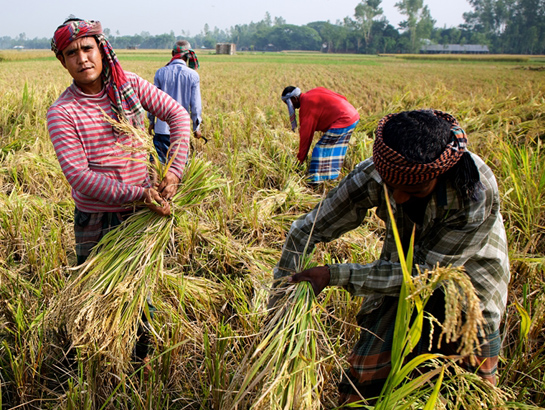In mid-summer 2019, after 15 years as CEO of HarvestPlus, I “retired” to a mostly rural area of the Philippines. My wife Cristina and I are in Los Banos, her hometown, which is nestled between an inactive volcano (Mt. Makiling) and a very large lake (Laguna de Bay) in the geographic middle of Laguna province bordering Metro Manila. The Manila airport in the southern part of the city is about a 90-minute drive north.
The northern part of Laguna province is becoming increasingly urbanized, virtually a part of Metro Manila, while the southern part is rural, densely populated, and dominated by highly diversified agricultural production, although rice is still the most important crop. Cristina and I have been under lockdown in this area for several weeks.
The population of Los Banos is about 125,000, which is distributed among 14 smaller administrative units called “barangays.” Each barangay has an elected barangay captain and council. According to figures posted online, as of May 1, 2020, 482 COVID-19 tests had been administered in Los Banos. Of these, 293 cases were negative, 36 were positive, and 153 results were not yet available from labs in Manila. Nine of the 36 positive cases have recovered, and there have been 4 deaths. We reside in Barangay Tuntungin-Putho with one active, confirmed case, 12 “probable” cases, and 3 “suspected” cases. These latter fifteen are presumably a subset of the 153 persons awaiting test results.
While we personally remain safe, and consider ourselves extremely fortunate under the circumstances, many families in Tuntungin-Putho have been adversely affected economically by the “Enhanced Community Quarantine,” or ECQ. Tuntinugin-Putho has approximately 1,800 households with a wide range of household incomes. A few well-off families live in subdivisions, while others reside in crowded conditions, “squatting” on land to which they have no title of ownership (around the hillsides at the base of Mt Makiling).
Tuntungin-Putho is not a farming community, more of a “suburb” of Los Banos, on the edge of the University of the Philippines at Los Banos, the country’s premier agricultural university. Many living in the subdivisions are trained and employed in agriculture, so we have our vegetable gardens. Unfortunately, this is not the case for most who are living in crowded areas without extra land.
The Impact on Families
By local estimates, 1,000 of the 1,800 families in Tuntungin-Putho, who had been earning daily wages, are now unemployed, with no financial cushion to lean on. Almost immediately after the ECQ was implemented, people began foraging for fruits and vegetables growing wild on Mt. Makiling. Once the ECQ is eased to some extent, it is likely that the previous levels of daily-wage employment will not return for some time. Even those in the middle class fear that their current jobs will disappear permanently.
 As of this writing, we were beginning our seventh week of ECQ, during which there have been three government food handouts to the 1,000 families: one provided by the barangay, one provided by the provincial government of Laguna, and one provided by the municipal government of Los Banos. On two occasions, the ration per family was three kilograms of milled rice, two packages of instant noodles, one package of instant coffee, one can of sardines, and one can of corned beef. It is easier logistically not to provide fresh produce, especially when target households do not have proper storage for perishables. Processed foods do not spoil and can be consumed over a number of days. And elected officials want to avoid giving foods that many people may not like, or may not be part of their usual dietary pattern.
As of this writing, we were beginning our seventh week of ECQ, during which there have been three government food handouts to the 1,000 families: one provided by the barangay, one provided by the provincial government of Laguna, and one provided by the municipal government of Los Banos. On two occasions, the ration per family was three kilograms of milled rice, two packages of instant noodles, one package of instant coffee, one can of sardines, and one can of corned beef. It is easier logistically not to provide fresh produce, especially when target households do not have proper storage for perishables. Processed foods do not spoil and can be consumed over a number of days. And elected officials want to avoid giving foods that many people may not like, or may not be part of their usual dietary pattern.
According to William Dar, the Secretary of Agriculture, the African swine flu hit the pork industry before COVID-19, and recently many pork producers switched to poultry production. When the abnormally large supply of chickens was ready for market, demand abruptly went down due to unemployment under the lockdown. I assume due to (temporarily) low poultry prices and perhaps facilitation through the Department of Agriculture, this allowed the municipality of Los Banos to provide one live chicken per household as their (so far) one dole out to needy families.
One wealthy family in the barangay has sponsored two giveaways—each time rice and one whole dressed chicken to each of the 1,000 families. My own estimate is that each food pack might have cost about USD 5 per household (say, USD 1 per family member), or a total of USD 5,000 per barangay-wide give away. This was a coordinated effort of the donor family with food wholesalers, and the barangay officials for distribution to the households.
Even under the “old normal,” mineral and vitamin deficiencies were a serious problem in the Philippines due to low incomes and rising prices of nutrient-dense vegetables, fruits, and animal products. At least the overall trend was one of improvement. Now under COVID-19, the trend is in the wrong direction, as this narrative serves to illustrate; it is an experience being repeated in community after community and country after country.
Malnutrition will continue to worsen in LMICs until a vaccine is available in quantity in these countries. My own non-expert guess is that this will take two years, which may be optimistic. Government resource constraints are a major obstacle for dealing directly with COVID-19 (testing and treatment), its indirect effects (for example, safety net programs and getting economies re-ignited), and at the same time to continue regular nutrition and health services once quarantines are lifted.
A Role for Biofortified Crops
What can/will LMIC governments do under these circumstances? For example, to mitigate food insecurity at the outset of the pandemic, the Philippine Department of Agriculture has been given additional funding to increase domestic rice production and otherwise ensure adequate food supplies. History teaches us that the government will closely monitor the price of rice. Higher rice prices could mean political instability. Agriculture and food systems continue to operate even under lockdown, albeit with some unavoidable constraints and inefficiencies.
Under these difficult circumstances, in countries where biofortified varieties of widely consumed staple crops have already been approved for release, biofortification is an intervention that can be implemented to help mitigate the rise in mineral and vitamin deficiencies at virtually no extra cost to governments and consumers. Multiplying biofortified seed and producing biofortified crops cost the same as multiplying non-biofortified seed and producing non-biofortified crops. Biofortified crops also contain higher levels of essential micronutrients that will help people stay healthy and productive.
Biofortified rice is not currently available for distribution in the Philippines, but biofortified crops are available in many other countries. For example, in Bangladesh, large quantities of seed of several zinc rice varieties are already available. The Bangladesh Agricultural Development Corporation (BADC), a government entity, is responsible for a high proportion of rice seed multiplied and sold to farmers each year. By immediately increasing the proportion of biofortified seed produced through the Bangladesh Rice Research Institute (BRRI) and BADC, zinc intakes in Bangladesh perforce will be increased.
Yields of biofortified crops are high. Therefore, the market price to consumers of biofortified foods will be the same as for non-biofortified foods. Substituting biofortified food staples in diets, at a one-for-one rate to non-biofortified foods, provides additional nutrients (an additional 20-40 percent of daily requirements) at no extra cost to family food budgets. Biofortified staple foods not only make a contribution to better nutrition under COVID-19—they will contribute to provide more-nutritious food supplies after COVID-19 is fully contained. The benefits of biofortified crops sustain harvest after harvest.
To repeat: Biofortification can be implemented even under lockdown and at virtually no extra cost to governments and consumers. This is not magic. This is the result of 17 years of investments in agricultural and nutrition research to develop high-yielding, high-nutrient staple food crops. Now, under the difficult conditions of COVID-19, is an opportunity to reap the rewards of this long-term investment in improved nutrition.
Note: Howarth “Howdy” Bouis is Founding Director of HarvestPlus and Emeritus Fellow of the International Food Policy Research Institute (IFPRI). Bouis shared the World Food Prize in 2016 in recognition of his seminal efforts to advance development and implementation of staple crop biofortification.
